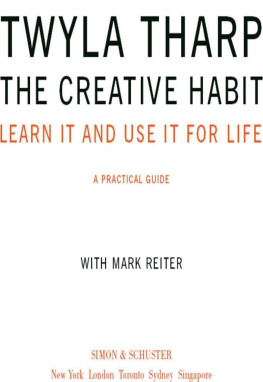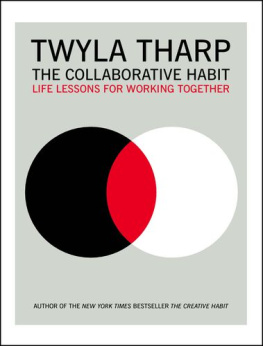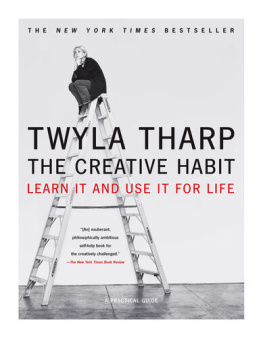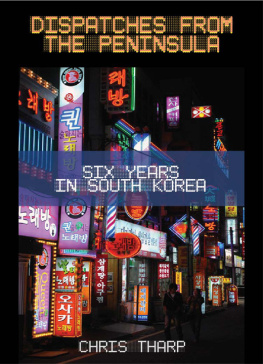
Also by Twyla Tharp
Push Comes to Shove: An Autobiography

SIMON & SCHUSTER
Rockefeller Center
1230 Avenue of the Americas
New York, NY 10020
Copyright 2003 by W.A.T. Ltd.
All rights reserved, including the right of reproduction in whole or in part in any form.
SIMON & SCHUSTER and colophon are registered trademarks of Simon & Schuster, Inc.
Library of Congress Cataloging-in-Publication Data
Tharp, Twyla.
The creative habit : learn it and use it for life : a practical guide / Twyla Tharp, with Mark Reiter.
p. cm.
1. Creative ability. 2. Creative thinking. 3. Creation (Literary, artistic, etc.).
I. Reiter, Mark. II. Title.
BF408.T415 2003.
153.3'5dc22 2003057389
ISBN-13: 978-1-4391-0656-3
ISBN-10: 1-4391-0656-8
Visit us on the World Wide Web:
http://www.SimonSays.com
To my mother, Lecille Confer Tharp,
for making sure I had all the tools I would need.
To my father, William Albert Tharp,
for giving me the DNA to build things from scratch.
To my son, Jesse Alexander Huot,
for helping me create each new day.
And those who had seen it told how he who had been possessed with demons was healed.Luke 8:36
CONTENTS
The Creative Habit
Chapter 1
I walk into a white room
I walk into
a large white room. Its a dance studio in midtown Manhattan. Im wearing a sweatshirt, faded jeans, and Nike cross-trainers. The room is lined with eight-foot-high mirrors. Theres a boom box in the corner. The floor is clean, virtually spotless if you dont count the thousands of skid marks and footprints left there by dancers rehearsing. Other than the mirrors, the boom box, the skid marks, and me, the room is empty.
In five weeks Im flying to Los Angeles with a troupe of six dancers to perform a dance program for eight consecutive evenings in front of twelve hundred people every night. Its my troupe. Im the choreographer. I have half of the program in handa fifty-minute ballet for all six dancers set to Beethovens twenty-ninth piano sonata, the Hammerklavier. I created the piece more than a year ago on many of these same dancers, and Ive spent the past few weeks rehearsing it with the company.
The other half of the program is a mystery. I dont know what music Ill be using. I dont know which dancers Ill be working with. I have no idea what the costumes will look like, or the lighting, or who will be performing the music. I have no idea of the length of the piece, although it has to be long enough to fill the second half of a full program to give the paying audience its moneys worth.
The length of the piece will dictate how much rehearsal time I need. This, in turn, means getting on the phone to dancers, scheduling studio time, and getting the ball rollingall on the premise that something wonderful will come out of what I fashion in the next few weeks in this empty white room.
My dancers expect me to deliver because my choreography represents their livelihood. The presenters in Los Angeles expect the same because theyve sold a lot of tickets to people with the promise that theyll see something new and interesting from me. The theater owner (without really thinking about it) expects it as well; if I dont show up, his theater will be empty for a week. Thats a lot of people, many of whom Ive never met, counting on me to be creative.
But right now Im not thinking about any of this. Im in a room with the obligation to create a major dance piece. The dancers will be here in a few minutes. What are we going to do?
To some people, this empty room symbolizes something profound, mysterious, and terrifying: the task of starting with nothing and working your way toward creating something whole and beautiful and satisfying. Its no different for a writer rolling a fresh sheet of paper into his typewriter (or more likely firing up the blank screen on his computer), or a painter confronting a virginal canvas, a sculptor staring at a raw chunk of stone, a composer at the piano with his fingers hovering just above the keys. Some people find this momentthe moment before creativity beginsso painful that they simply cannot deal with it. They get up and walk away from the computer, the canvas, the keyboard; they take a nap or go shopping or fix lunch or do chores around the house. They procrastinate. In its most extreme form, this terror totally paralyzes people.
The blank space can be humbling. But Ive faced it my whole professional life. Its my job. Its also my calling. Bottom line: Filling this empty space constitutes my identity.
Im a dancer and choreographer. Over the last 35 years, Ive created 130 dances and ballets. Some of them are good, some less good (thats an understatementsome were public humiliations). Ive worked with dancers in almost every space and environment you can imagine. Ive rehearsed in cow pastures. Ive rehearsed in hundreds of studios, some luxurious in their austerity and expansiveness, others filthy and gritty, with rodents literally racing around the edges of the room. Ive spent eight months on a film set in Prague, choreographing the dances and directing the opera sequences for Milos Formans Amadeus. Ive staged sequences for horses in New York Citys Central Park for the film Hair. Ive worked with dancers in the opera houses of London, Paris, Stockholm, Sydney, and Berlin. Ive run my own company for three decades. Ive created and directed a hit show on Broadway. Ive worked long enough and produced with sufficient consistency that by now I find not only challenge and trepidation but peace as well as promise in the empty white room. It has become my home.
After so many years, Ive learned that being creative is a full-time job with its own daily patterns. Thats why writers, for example, like to establish routines for themselves. The most productive ones get started early in the morning, when the world is quiet, the phones arent ringing, and their minds are rested, alert, and not yet polluted by other peoples words. They might set a goal for themselveswrite fifteen hundred words, or stay at their desk until noonbut the real secret is that they do this every day. In other words, they are disciplined. Over time, as the daily routines become second nature, discipline morphs into habit.
Its the same for any creative individual, whether its a painter finding his way each morning to the easel, or a medical researcher returning daily to the laboratory. The routine is as much a part of the creative process as the lightning bolt of inspiration, maybe more. And this routine is available to everyone.
Creativity is not just for artists. Its for businesspeople looking for a new way to close a sale; its for engineers trying to solve a problem; its for parents who want their children to see the world in more than one way. Over the past four decades, I have been engaged in one creative pursuit or another every day, in both my professional and my personal life. Ive thought a great deal about what it means to be creative, and how to go about it efficiently. Ive also learned from the painful experience of going about it in the worst possible way. Ill tell you about both. And Ill give you exercises that will challenge some of your creative assumptionsto make you stretch, get stronger, last longer. After all, you stretch before you jog, you loosen up before you work out, you practice before you play. Its no different for your mind.
I will keep stressing the point about creativity being augmented by routine and habit. Get used to it. In these pages a philosophical tug of war will periodically rear its head. It is the perennial debate, born in the Romantic era, between the beliefs that all creative acts are born of (a) some transcendent, inexplicable Dionysian act of inspiration, a kiss from God on your brow that allows you to give the world The Magic Flute, or (b) hard work.
Next page







